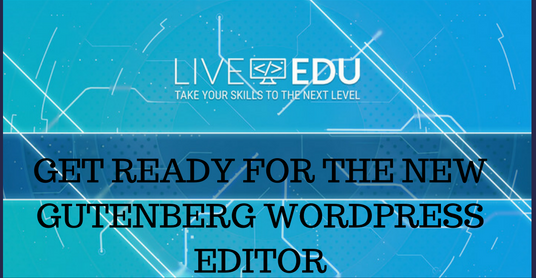
Brace yourself: WordPress 5.0 may include the new Gutenberg editor as part of its core!
The current tired TinyMCE text editor that has served millions of WordPress users for several years will soon be deprecated with a new interface for editing posts and pages.
This is going to be one of the major updates since the launch of the WordPress platform. Because Gutenberg will influence the whole WordPress publishing experience, you should get ready for its release.
Of course, WordPress is a popular content management platform that is versatile and user-friendly. For example, Awakekat, who has over 16 years of front-end web development experience, teaches people how to maximize the use of WordPress by creating their own themes. You can watch and learn from his practical projects here.
So, which new changes are coming with Gutenberg?
The present WordPress visual editor has not undergone major changes over the years, even as other competing platforms have integrated refreshing and modern interfaces to make writing and publishing simple and hassle-free.
If you are not familiar with it, the Gutenberg editor for WordPress is an entire overhaul of the present editing experience. It is WordPress’ promise to make writing rich pages and posts effortless and intuitive.
The Gutenberg editor for any up-to-date WordPress platform is created to be free from distractions, while emphasizing on ease of creating content. Most of the features of the earlier version have been hidden or moved, allowing users to create content easily.

At the heart of Gutenberg is blocks. Typically, blocks are pre-constructed modules that allow you to lay out your content clearly and consistently.
Currently, styling content is difficult and will require that you integrate various functionalities, such as shortcodes, theme options, post formats, and other formatting elements.
However, Gutenberg blocks provide you with a unified technique of styling content without advanced programming skills. It’s exactly what beginners want to make the most of the WordPress platform.
With the blocks, you can quickly and confidently customize the layout of your content to meet your tastes and preferences.
For example, you can include blocks through clicking on the plus icon found on the bottom left section of the interface. Thereafter, a menu will appear indicating the various block options you can add.

Gutenberg pros and cons
As earlier mentioned, Gutenberg brings to WordPress what is has been missing for a long time: clean design. It comes with a minimal design that has all the essential tools for creating interactive and engaging content, without relying on menu bars.
However, the largest drawback could be lack of full support for some popular WordPress plugins such as Jetpack and Yoast SEO, which could make these beneficial plugins ineffective.
However, because Gutenberg is still under active development, we expect more features to be added that will not lead to conflicts with the already existing WordPress plugins.
Furthermore, since Gutenberg is going to be merged in the future WordPress versions, backwards compatibility could be a big issue. This could force developers to rework their existing applications to ensure smooth operations with the changes. However, the team behind Gutenberg could introduce a wrapper to allow for TinyMCE backwards compatibility.
Conclusion
Gutenberg is presently available as a plugin and it is scheduled to be merged with the WordPress core during the release of version 5.0 later in 2018.
Although several grey areas still exist such as if users will be able to disable it, there is already a lot of fuss about project Gutenberg in the WordPress community.
What do you think about Gutenberg? Do you think it will improve your WordPress writing experience?
Please let us know in the comment section below.







